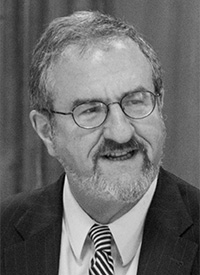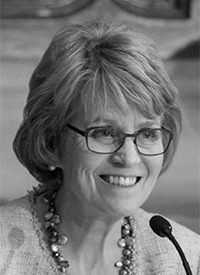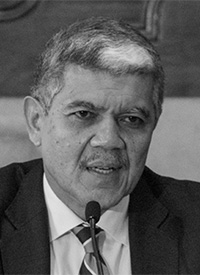On April 4, 2016, Mark S. Schlissel (President of the University of Michigan), Mary Sue Coleman (President Emerita of the University of Michigan), Patrick Doyle (President and CEO of Domino’s and Chair of the Board of Directors of the Business Leaders for Michigan), M. Roy Wilson (President of Wayne State University), and Lou Anna K. Simon (President of Michigan State University) participated in a discussion at the University of Michigan about public research universities and their role in serving the public interest in Michigan. The program served as the Academy’s 2036th Stated Meeting. The following is an edited transcript of the presentations.

Mark S. Schlissel
Mark S. Schlissel is the 14th President of the University of Michigan. He was elected a Fellow of the American Academy of Arts and Sciences in 2015.
The ideas being examined and advanced by the Academy’s Lincoln Project are essential to the future of our nation. My predecessor at the University of Michigan, Mary Sue Coleman, has characterized this project as addressing the financial and moral commitment of our country to public higher education. This is a conversation we must have.
Parents often ask me what is special about a research university. They want to know why they should send their son or daughter to be educated at Michigan or Michigan State or Wayne State.
I tell them that at a research university your child will learn from faculty who are redefining the current limits of human knowledge and posing the next questions to be answered, teaching students not just what we know but how to look around corners, how to ask questions, how to doubt and be skeptical, how to demand proof and evidence.
At a research university, students get to participate in the act of discovery by working with faculty on their research projects – a mode of learning that is much more active than what one finds at less research-intensive universities. Great public research universities are thus of tremendous value to the students they educate.
They are also economic drivers. Think about what the United States would be like without the discoveries that came from research-intensive universities. They spawn entire new industries. They produce advances in health care and engineering and communications. The Internet, our ubiquitous iPhones, and all of the other technologies we rely on for modern life are heavily dependent upon research done at our great public research universities.
However, America’s public research universities face big challenges. We are in the midst of a period of massive disinvestment in public goods, especially public higher education, by elected governments, both state and national. Federal support for research is flat or, when you take inflation into account, declining.
We also face demographic challenges. We have had difficulty first diversifying and then maintaining the diversity of our student body and our faculty. Building inclusive learning environments has become increasingly challenging.
The Lincoln Project is bringing together federal and state higher education and business leaders. It is working to encourage the development of new federal, corporate, and philanthropic sources of support to sustain public higher education across our nation. We have an outstanding example of collaboration right here in Michigan with the University Research Corridor, a group started by Mary Sue Coleman and Lou Anna Simon about a decade ago. It is a collaboration of Wayne State, Michigan State University, and the University of Michigan.
This year the economic impact of these three universities on the state will be $17.5 billion. For every dollar invested in the three universities, the state gets back $22 in financial benefit.
We are highly ranked among similar clusters of research universities around the country. We are first in enrollment, first in total degrees granted, first in medical degrees. And we are number two in advanced degrees in high tech fields such as engineering and the sciences.
This is all critical for the economic resurgence and the continuing competitiveness of the state of Michigan, as well as our nation as a whole. This year we are issuing a special report on the work being done, collaboratively and individually, by Michigan’s three public research universities to promote Detroit’s recovery.
The Business Leaders for Michigan, represented today by Patrick Doyle, is a statewide organization made up of the chief executives of major businesses from the different sectors of the state’s economy, including the leaders of the major public research universities. This group is involved in promoting the importance of investment in public higher education to the citizens of Michigan as part of its plan for the economic revitalization of the state.
We have a business engagement center here at the University of Michigan that has partnered with many state universities as well as businesses of all sizes. Along with Michigan State, Wayne State, the University of Michigan-Dearborn, Western Michigan, and Michigan Tech, the center launched the Michigan Corporate Relations Network. This public/private partnership has helped small and medium-size businesses access research expertise and students from our institutions. With essential support from the Michigan Economic Development Corporation, the center has worked to facilitate tech transfer from Michigan universities to Michigan businesses.
Recently, I welcomed attendees to the first meeting of a new leadership council called MForesight, a federally sponsored think tank of leaders from research-intensive industries, research-intensive universities, and federal research support agencies. The council’s mission is to identify emerging technologies from universities that can lead to the next generation of tech industry development, as well as to help identify which new technologies the manufacturing sector in particular should be paying careful attention to and which we need to develop into platforms for future economic growth.
A better Michigan will mean a better future for all of us. We all share a passion and sense of optimism, and I believe that the institutions of public higher education in Michigan – thanks to their complementary missions, complementary strengths, and shared values – can propel our state forward. We can make Michigan a powerful global leader in economic prosperity once again.

Mary Sue Coleman
Mary Sue Coleman is President Emerita of the University of Michigan and President of the Association of American Universities. She was elected a Fellow of the American Academy of Arts and Sciences in 2001.
The focus of our discussion today is on public research universities, their role, and the ways in which they integrate themselves into the intellectual infrastructure of the country and why keeping that infrastructure strong is so important. I thought I would start out, though, by giving some background about the Lincoln Project, which is nearing the end of its third year. The stated goal of the project is to look at the condition of public research universities across the country.
The first thing we had to do was pick a cohort. So we looked at the Carnegie Classification of Institutions of Higher Education and picked the “Very High Research Activity” and “High Research Activity” universities. There was a method to our madness in doing this! By picking these 143 institutions, we had at least one in every state.
These institutions also educate about 75 percent of the undergraduates in the country and about 60 percent of the doctoral students. They have a huge impact on research activity.
As a consequence of our work, we have released four publications so far. The first describes the benefits of public research universities as well as the changing demands on these institutions. The second examines state financing of higher education, describes the challenges state governments face, and assesses the prospects for greater state support in the future.
The third report details the most common financial models that sustain public research universities, describes institutional responses to the changing financial climate, and examines new ideas for diversifying and enhancing funding sources in the future. The fourth describes the impact of public research universities on economic growth, civic engagement, scientific and technological discovery, and the well-being of individual students.
On April 7 at the National Press Club in Washington, D.C., Robert Birgeneau – my cochair on the Lincoln Project and chancellor emeritus of the University of California, Berkeley – and I will present our final recommendations on how states, the federal government, and private corporations and foundations can help support public research universities in the future.
Although public research universities are but one slice of a higher education pie that also includes community colleges and private colleges and universities, this particular group of institutions provides a service for the country and for corporate America that is unique. In the state of Michigan, five institutions are classified as part of the Lincoln Project cohort: Michigan Tech, Western Michigan University, the University of Michigan, Wayne State University, and Michigan State University.
In the course of formulating our recommendations, we held regional meetings all over the country. We did so at a particularly interesting time. As a result of the Great Recession, public universities have found themselves having to adapt to a funding landscape that is very different from only ten years ago. Seeing how the institutions have adapted to their changing circumstances provided both moments for optimism and cause for alarm, because we are in jeopardy of losing a very valuable resource.

Patrick Doyle
Patrick Doyle is President and CEO of Domino’s Pizza and Chair of the Board of Directors of Business Leaders for Michigan.
There are moments in your life when you are sitting somewhere and wonder exactly how you got there. So here I sit, the pizza guy, with four of the great academic leaders, not only in the state but in the country.
My involvement with higher education, apart from attending the University of Michigan, began about six years ago, as part of Business Leaders for Michigan, an organization of the 80 largest businesses in the state of Michigan, as well as the state’s three public research universities. The inclusion of the universities was purposeful. We believe our state and country have been blessed with truly extraordinary public research universities.
The strength of the university system in Michigan reflects investments made by the state over many decades. As business leaders, our goal is for Michigan to again become a top-ten state for personal income and job growth. Our sole purpose is to help the economy in the state of Michigan grow and prosper.
As we looked at where we need to invest more as a state in order to strengthen existing assets, we identified a handful of areas, at the top of which were our public universities. We have made some progress on that front.
One of the strengths of our country is that we have the single finest public university system in the world. But we think it is in peril. The financing of public universities has changed dramatically over the course of the last three or four decades.
We have moved away from a model in which most funding came from states, with significant funding for research and support for students (in the form of Pell grants) coming from the federal government. We now have a system where more and more university revenue is borne by tuition. This has led to a situation in which access to public universities has been restricted financially.
We think this is something that needs to be addressed. We also believe that the research and knowledge being generated by universities are and will continue to be critical to American economic growth, especially as economies become more and more about knowledge and potentially less about making things – although, if you are making things, the future will be about how to make them more efficiently and with fewer resources.
Our public research universities give us, as a country, an extraordinary competitive advantage and extraordinary strength. This must not only be maintained but strengthened. And so that is how the pizza guy wound up sitting at the table.

Lou Anna K. Simon
Lou Anna K. Simon is President of Michigan State University.
We all want to lead with cutting-edge knowledge and make it broadly accessible. That is the essential role of the modern-day land-grant university.
So in 2007 – 2008, at the depth of the difficulty in Detroit, Michigan State University made a decision to open an office on Woodward Avenue, because we believed in Detroit. That is what a land-grant university does, and we do it across the state. We have a new research building in Grand Rapids and medical facilities in Midland, Traverse City, and the Upper Peninsula.
In Detroit, we are working with organizations to look at food and food systems. In Holland, we have a bio-economy institute. In Flint, a proposal to the Mott Foundation five years ago for a new curriculum in medicine and public health soon proved to be very useful when the Flint water crisis occurred.
Our goal is to ensure that access to cutting-edge knowledge is available to people in a variety of ways. To achieve that, we are working together, collaborating with our fellow state universities and with Michigan companies.
Faculty, even within the same department, might compete on individual grants – that will never change – but in looking at the bigger picture it is not about competition. When it comes to the really big things, we are looking at how we can pool our efforts.
That is how the Facility for Rare Isotope Beams came about. Working with the University of Michigan and the U.S. Department of Energy, we were able to imagine something really big for the state. And if we can succeed with a project like that, we can have more. That is the attitude we have to have as we look at outreach and engagement.
And we are engaged. We are in every county in the state. We have 13 food systems experiment stations scattered around the state. Through our medical programs we reach as many residents as the University of Michigan. We bring cutting-edge knowledge to the community.
One of the things I appreciate about the work of Business Leaders for Michigan is that they have taken a tough look at us. They didn’t just listen to a bunch of university presidents and their tale of woe. They looked at the data, challenged us to be best in class in a variety of things, challenged us to be innovative in how we think about the work we do, both in the community and with each other, and they challenged us to think in ways that promote partnership.
That has been extraordinarily valuable. We have taken what we have learned and tried to apply it across our operations, collaborating wherever we can. We are still going to run a few of the same programs in the same places, but rather than simply competing we are going to try to do it in a way that is collaborative and augments the strengths we each bring to the table.

M. Roy Wilson
M. Roy Wilson is President of Wayne State University.
Universities have been engaged with their communities for a long time; this is nothing new. But over the past ten years the nature of the engagement seems to have changed. In the past, universities engaged with their community by doing something for or to the community (for example, conducting a study of the local population).
Now there seems to be more of a two-way street and a deeper financial commitment to the communities of which universities are a part. This is true not just of our land-grant universities. Over the past couple of decades, urban universities across the country, including Wayne State, have had a tremendous impact on the environments of which they are a part.
Wayne State’s contribution to Midtown Detroit Inc., an organization working to revitalize the Midtown area, is one example. Thanks to such anchor institutions as Wayne State and the Henry Ford Health System and ongoing financial contributions from the Kresge, Ford, and other foundations, $80 million has been raised that goes directly back to the community for beautification, retail development, and all kinds of activities related to the development of Midtown.
Another initiative is the M-1 rail, which runs north-south on Woodward Avenue, right through the Wayne State campus. Obviously, this is something that will be enormously beneficial for us. In recognition of that fact, we have invested $1 million a year for the past three years in the rail line’s development, because it is a public-private partnership that will benefit the entire region, and we thought we needed to show our commitment to its development.
In the past, particularly in urban universities, public safety officers patrolled the university campus but nowhere past the university perimeter, which would often be marked by an actual physical barrier. Our public safety officers, however, have broadened that boundary to include all of Midtown. As a result, the response time for any crime in the Midtown area is less than 50 seconds or so.
Businesses feel safe locating to the area because they feel like they have their own police force. Residents feel safe because the police force is not confined to the Wayne State campus but patrols throughout Midtown. What benefits Midtown benefits Wayne State.
We are involved in a lot of building projects too. As with many universities, we are fortunate to own some of the land surrounding us, and we have been deliberate about what gets developed on those pieces of land. A defining factor for us has been how each development will impact the community.
One major development involves mixed retail – higher-end residential units, with perhaps a boutique hotel that would benefit the community. These sorts of projects will really enhance the Wayne State perimeter.
We also own some land where the M-1 rail will go through. There, despite offers from people wanting to buy or lease this land from us, we have decided to take a wait and see approach because we do not know what is going to happen in that whole area once the M-1 rail goes through. We are not ready to give up the option to develop that piece for something the university needs.
We have also been more engaged with the business community in other ways. A good example is the Mike Illitch School of Business, which we are building on property owned by the Illitches, right next to the new Red Wings hockey arena.
What I am most excited about, though, is the curriculum. One of the things we have talked about with the Illitches is having them help us with the curriculum that focuses on entertainment and sports. They have agreed to be active partners with us in developing that curriculum and in offering internships and other opportunities to our students.
These are just some of the examples of the new ways we are engaging with the community. The university has always been engaged, but this feels different, and I look forward to seeing where these kinds of new engagement might take us.
Panel Discussion
Mary Sue Coleman
Patrick, you came from the corporate perspective and have been advocating for increased funding for higher education in the state of Michigan. That effort has had some success. We are not back to where we were in 2002, when I was recruited to Michigan, but we are not being cut anymore. When you went to talk to legislators, what was the most persuasive thing you could tell them? What worked best for you?
Patrick Doyle
First, we needed to dispel some myths; for instance, the perception that tuition and tuition increases are a direct reflection of spending increases in the universities. That is simply incorrect. Tuition increases are, fundamentally, a reflection of the cut in financial support from the states. The offset has been almost exactly dollar for dollar.
So we need to lay out the facts for legislators, explain that what looks like a cost problem is actually a shifting of resources. Second, we need to look at the economic impact of the universities – both direct, from a research and employment standpoint, as well as on family income.
And while you will read stories about how some people with a four-year degree are not yet employed, the reality is that income levels for people with a four-year degree are higher than those with a two-year degree, a high school degree, or no degree at all. Compared to having only a high school education, having a four-year degree adds, on average, about $1 million in earnings over the course of the career of the person who receives the degree. That is a straight economic return to the state for investing in higher education. The dollars are being wisely spent.
Universities have to continue to look at efficiencies in the system and find ways they can collaborate and be transparent about the expenditures that are being made, but the bottom line is that states realize a good return on investment from putting more dollars into higher education, and we have started to turn the corner on that.
Lou Anna K. Simon
Patrick, from my perspective, business leaders understand how to shift money around, how to make cuts in one area in order to be able to expand in another. And that is a hard message for people to understand.
At Michigan State we have had a 38 percent increase in STEM student credit hours. That is an expensive shift if we do it right, if we offer great lab experiences and all the hands-on stuff that goes with it. But over a long period of time, we have had funding losses that amount to real dollars, not just inflation-adjusted dollars. Business leaders seem to understand what it means to make adjustments in one area to fund something else that is higher value and in demand, but that requires making tough decisions.
For a big organization in the public sector to make those kinds of changes, however, is incredibly tough, which is something people don’t understand. Whether it is picking up the loss of financial aid from the state and trying to make that up in some way; whether it is STEM credit hours; whether it is dealing with all your legacy costs – business leaders were great at helping us clarify our message and carry it forward, because you were already doing that in your own businesses.
M. Roy Wilson
I don’t want to be critical, but some states have valued their research universities more than others. One in particular that comes to mind is New York. Between 5:00 and 6:00 every morning I tend to watch one of the news stations – typically CNN, but the others as well – and every morning on whichever station I am watching, a commercial comes on; it is the state of New York trying to bring businesses into the state.
One of the factors they tout for why business should go to New York is the life sciences research that is going on in Buffalo now. The medical school has moved from the suburbs into the city of Buffalo, and that is a $375 million investment, plus all of the peripheral things that go along with life sciences research. The state thought this was important enough that it is on national television every morning between 5:00 and 6:00.
Lou Anna K. Simon
If you look at the aggregate enrollment in the research universities in the state, they have not declined. But the proportion of the state’s higher education budget that goes to research universities has declined.
Mary Sue and I sometimes reminisce about the Sputnik era and how the country galvanized its support for science and technology. We were determined to win this competition with the rest of the world. It is the same today, but with higher education.
Mary Sue Coleman
The interesting thing we discovered as part of the Lincoln Project was that during the Great Recession, over the last ten years, the sector of public education that was cut the most severely was public research universities. Their funding was cut by 34 percent per full-time-equivalent student. Yet by the end of the Great Recession we were educating 30 percent more students than at the beginning.
We were cut more than comprehensive universities, more than community colleges, more than K – 12, which was hardly cut at all. That is not to say that investment in K – 12 is not important – it is important – but what we wanted to highlight in this project is how much this slice has been put at a disadvantage, relative to other sectors of higher education.
This is part of the economic engine of the country – a very important part. Because one of the things we have become aware of is how widespread the financial impact of our public research universities is.
I was in Nashville last week talking to a group of legislators, and I pointed out the money being spent in Tennessee as a consequence of research being conducted at universities in Michigan, Wisconsin, and Illinois. They were astounded. They had assumed that if research money went to Michigan State or to Wayne State or to the University of Michigan, that it all stayed in East Lansing and Detroit and Ann Arbor.
No, no, no. That money gets spread across the country, because the researchers have to buy goods and services to conduct their research. This kind of impact is so important to the nation, and we have got to get the message out.
M. Roy Wilson
I think we can all agree that the typical or historical way that states allocate money to universities is not going to grow appreciably. We are not going to see some huge windfall from the states because they have decided to increase – out of the general fund – the proportion that goes to higher education versus one of the other areas.
So we have to think about innovative ways of getting more support. When I was in Nebraska, the chancellor of the University of Nebraska Medical Center and I prevailed upon the state to dedicate a third of its tobacco settlement dollars to medical research in the state of Nebraska. Only three institutions did such research, and we ended up getting $17 million a year, in perpetuity, to put toward our medical research. The state’s return on that money turned out to be $21 for every $1 invested.
I had the opposite experience – a lost opportunity, really – when I was at the University of Colorado. This was before marijuana was legal, but the state was contemplating legalizing it. I knew that fighting legalization was a losing battle, so I tried to prevail upon the university to insist that part of any tax on the sale of marijuana be used for medical research. For various reasons, that wasn’t done.
But the marijuana bill passed, and a ton of marijuana is now being sold in Colorado. It would have been great to have some of that money set aside for medical research at the University of Colorado, because Colorado is one of the states that may not only further diminish but discontinue funding for public higher education.
© 2016 by Mark S. Schlissel, Mary Sue Coleman, Patrick Doyle, Lou Anna K. Simon, and M. Roy Wilson, respectively